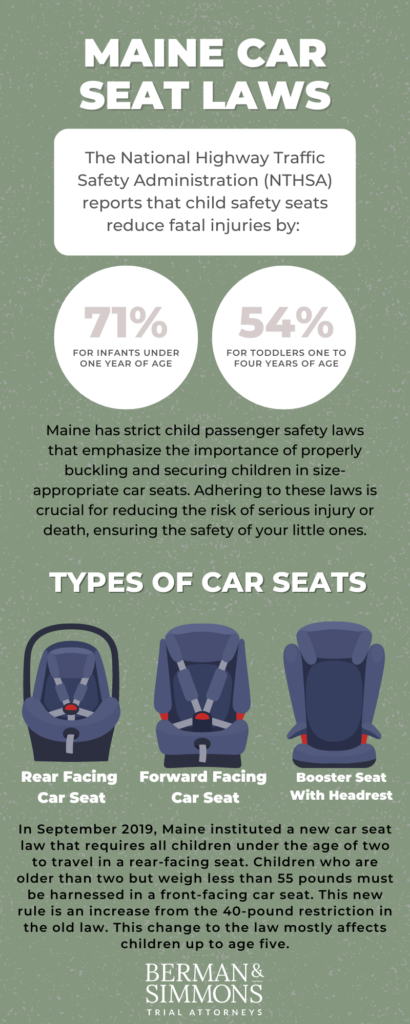According to the Centers for Disease Control and Prevention (CDC), motor vehicle crashes are the leading cause of death for the first three decades of an American’s life. The National Highway Traffic Safety Administration (NTHSA) reports that child safety seats reduce fatal injuries by 71% for infants under one year of age and by 54% for toddlers one to four years of age. Properly buckling and securing children into size-appropriate car seats are two ways to reduce the risk of serious injury or death. Maine has one of the strictest child passenger safety (CPS) laws in the country, and it’s important to know these car seat laws to keep your little ones safe.

Types of Car Seats
There are numerous types of car seats available on the market, but all car seat manufacturers must provide safety restraints that adhere to the Federal Motor Vehicle Safety Standards (FMVSS). If you’re unsure if you installed the car seat correctly, the Maine Bureau of Highway Safety conducts car seat checks for free.
Every child who weighs 40 pounds or less must be in a secured child restraint. The NTHSA advises that children from birth to age one always ride in a rear-facing seat. There are currently three types of rear-facing car seats on the market:
- Infant-only car seat: This seat is designed to click in and out of a base separately installed in your vehicle. Once removed from the vehicle, you can snap it into a stroller base. A benefit of this type of seat is that you don’t have to remove the infant from the seat, making it easier to get your child in and out of the vehicle. It is designed for a rear-facing position only and is for children from birth to age 2 or until the child reaches the weight or height limit.
- Convertible car seat: This seat typically lasts for several years as you can use it with children of various sizes. You can use this as a rear- or front-facing seat. If you don’t want to start with an infant-only car seat, you can place your infant in a convertible car seat. This option isn’t portable and isn’t as easy to move from one vehicle to the other.
- 3-in-1 car seat: Also known as an all-in-one seat, the 3-in-1 car seat is similar to the convertible car seat, except that it works as a booster as well. A benefit of this type of seat is that you only need one car seat from birth until your child is old enough to ride with just a seat belt.
Another type of car seat available is the front-facing booster. This type of seat is only for children riding in a forward-facing position, and the minimum weight requirement is typically between 30 to 40 pounds. Children can ride in a booster until they no longer need to use a car seat. It might have its own set of buckles or a harness, or you might use the vehicle’s seat belt. Your child’s height normally dictates which option is more comfortable if you have a choice. There are two types of boosters available:
- Booster seat with headrest: If your vehicle does not have headrests for people in the rear seat or if the headrests are unsafe, your child should be in a booster seat that includes a headrest. This is important because children can suffer serious injuries if their neck or head isn’t secure in an accident.
- Backless booster seat: If your vehicle has proper headrests, use this type of full-size booster seat for your child.
Children riding in booster seats must be able to sit with their backs against the back of the seat and their feet on the floor. They must also keep the seat belt properly fastened during the entire ride. This means the lap belt must be positioned snugly across the lap, not the waist, and the shoulder belt must fit across the chest and not under the arm or across the neck.
Maine Car Seat Laws
The NHTSA states that children age one through three should ride in a rear-facing seat for as long as possible. However, in September 2019, Maine instituted a new car seat law that requires all children under the age of two to travel in a rear-facing seat. Children who are older than two but weigh less than 55 pounds must be harnessed in a front-facing car seat. This new rule is an increase from the 40-pound restriction in the old law. This change to the law mostly affects children up to age five.
Once children exceed the height and weight limit set forth by the rear-facing car seat manufacturer, they can sit in a forward-facing car seat with a harness. Children under the age of eight who are less than 57 inches tall and weigh less than 80 pounds must ride in a booster seat. According to Maine law, once a child is at least 12 years of age and weighs more than 100 pounds, he or she can safely ride in the front passenger seat while wearing a seatbelt.
Authorities have the right to pull over any vehicle if the driver or passengers are not wearing a seat belt. Violators of the car seat laws are subject to up to a $100 fine for the first offense. Fines for a second offense can reach $125, while fines for third and subsequent offenses are $250.
The Bottom Line
Unfortunately, car accidents can happen even if you’re paying attention. A negligent driver could be distracted, paying attention to their phone or looking for something in their car. A child placed in the proper safety restraint has a better chance of avoiding serious injury than one not placed in a car seat. However, children can still sustain injuries even while in a car seat.
Hiring a Personal Injury Lawyer After a Car Accident
If you or a loved one has been in an automobile accident and suffered personal injuries due to someone else’s negligence, there are a lot of issues to consider, including insurance company tactics and how they may take advantage of you.
Berman & Simmons can help. We will answer your questions, explain all your legal options for a vehicle accident lawsuit, and provide a roadmap for what comes next.
Contact us today to schedule a free consultation.
